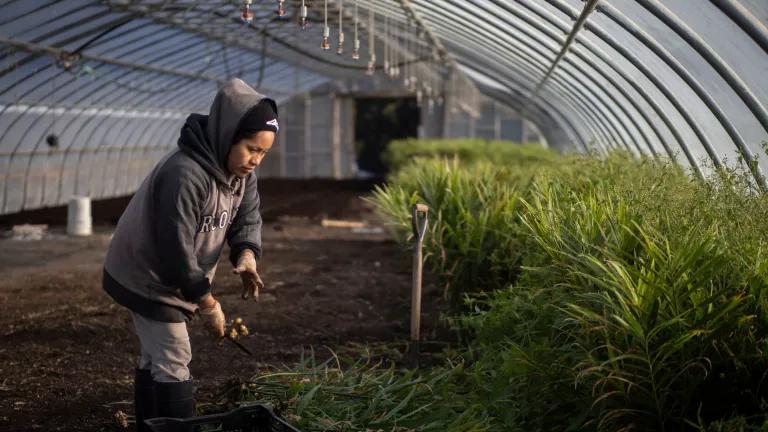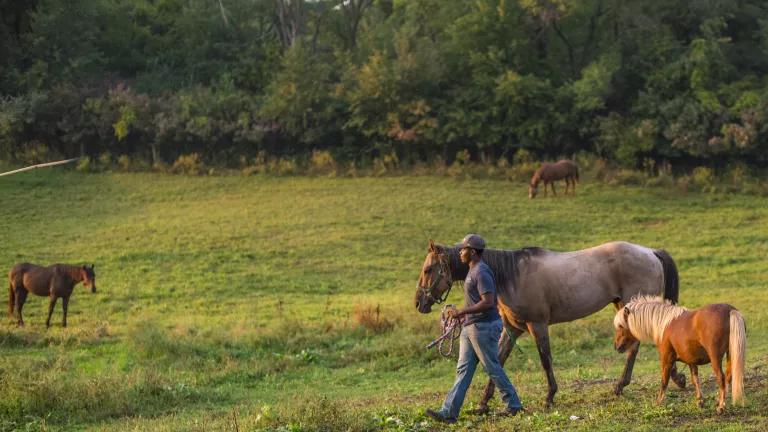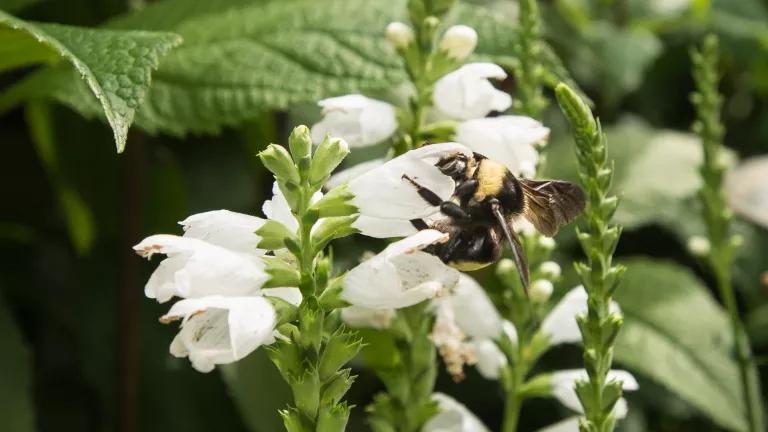Time to Transition to an Organic and Regenerative Future
Farming organically and regeneratively—with careful attention to soil health and ecosystems, and without reliance on fossil fuel-based pesticides and fertilizers—is a key piece in the climate puzzle, as well as a recipe for long-term resilience in our food supply.

A Sang Lee Farms staff member harvesting organic ginger, in Peconic, New York; the third-generation farm grows more than 100 varieties of organic specialty produce
We know farming organically and regeneratively—that is, with careful attention to soil health and ecosystems above and below ground, and without reliance on fossil fuel-based pesticides and fertilizers—is a key piece in the climate puzzle, as well as a recipe for long-term resilience in our food supply.
And the U.S. is full of producers who can and want to advance this transition, including:
- Indigenous, Black, and other farmers and ranchers of color who have fine-tuned regenerative practices for centuries;
- A new generation of innovative young and beginning producers ready to steward the land;
- Underappreciated farmworkers and farming communities with the expertise and ambition necessary to build a better food system;
- Producers who realize industrial agricultural practices no longer work because they are harmful to the soil and to people and communities; and
- Many more producers who care deeply about farming and their communities, and with the necessary information, mentorship, risk management tools, and social support could successfully farm in healthier and climate-friendly ways.
So what’s holding us back?
Simply put, the U.S. hasn’t made the long-term health of our food and farming system—and the people and resources who make it work—a priority. But it’s not too late.
To expedite our transition to an organic and regenerative future, the U.S. needs to invest in a comprehensive and easily accessible set of tools to support producers who are eager to take the lead, and entice more to join them.
Organic and Regenerative Agriculture Protect Health and Environment
Industrial agriculture, which has dominated the U.S. food system for decades, relies on extractive practices that degrade soil and animal health and pollute soil, air, and water with dangerous and fossil fuel-intensive chemicals. This approach has made agriculture a major source of greenhouse gas emissions, as well as a threat to health in communities and ecosystems across the country (and the globe). It cannot be sustained in the long-term.
Organic and regenerative agriculture—in contrast—are systems-based approaches to farming that focus on building healthy soil with cover crops, crop rotation, and compost, and without harmful chemicals. These types of farming protect the health of farmworkers, farming communities, ecosystems, natural resources, and consumers, while reducing the climate footprint of food production and making farming communities more prosperous.
Existing Resources for Producers Fall Short
Although they continue to grow, organic and regenerative approaches to farming receive nowhere near the public funding, research support, and technical assistance that industrial agriculture has enjoyed since the days of USDA Secretary Earl Butz. As a result, aspiring organic and regenerative producers are still underserved by federal agriculture programs.
In addition, significant practical and social hurdles continue to limit access to public resources. While some federal farm support programs specifically set aside funds for underserved producers, farming or ranching is a full-time job that leaves little time for smaller operations to learn about funding opportunities and navigate paperwork. In addition, requirements to provide matching funds or demonstrate certain types of experience can shut producers out of key programs.
These challenges are exacerbated by longstanding discrimination problems at USDA that make it extremely difficult to build trust between producers and the agency. Some producers of color continue to face overt discrimination in local USDA offices, and others struggle to overcome racism that is more subtle. For example, in Rural Coalition’s recent comments to USDA on racial equity, a Tribal producer described the discrimination that continues in his region as passive, but deeply harmful; farmers are dismissed and ignored by their local USDA offices until they give up. Producers also fear retaliation if they complain or speak up publicly.
A One-Stop Shop for Transition Support
In light of these challenges, it’s time for a fresh approach. A carefully crafted and well-funded organic and regenerative transition program would provide a new opportunity to promote farming practices that offer numerous public benefits, while also lowering barriers for producers who haven’t received a fair share of public support.
Simplicity and flexibility are key. The farmers and ranchers of our future bring a diversity of experience, resources, talents, and needs that cannot be adequately supported through a one-size fits all approach. Rather, our public policies need to provide producers and the organizations they trust with easily accessible and dynamic resources.
Critical transformational investments include grants for: shifting practices, offering and receiving mentorship, pursuing organic certification, scale-appropriate equipment, processing infrastructure, debt relief, land access, research, marketing, and other on-the-ground necessities. Transitioning producers also need regionally tailored and publicly funded research, as well as comprehensive technical assistance - ranging from business development, paperwork navigation tools (including language assistance), and help accessing complementary funding and resources like crop insurance, to practical advice for sustainably dealing with new pest and weed pressures that may arise as soil heals from extractive practices and treatment with toxic chemicals.
While existing programs that support conservation practices, underserved producers, and research provide critical resources that have contributed to the success of organic and regenerative agriculture in recent decades, these programs do not adequately or holistically meet the needs of small- and mid-sized operations or socially disadvantaged producers—and these existing investments are far too small to address the threats that climate change poses to our food system.
President Lincoln established the US Department of Agriculture almost 160 years ago, and he dubbed it “The People’s Department.” It’s past time for our leaders to ensure that USDA truly serves all people. Focused efforts to support a widespread transition to organic and regenerative agriculture would be an important step in the right direction.




